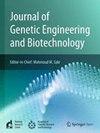靶向白斑综合征病毒VP28的对虾天然抗病毒候选药物的高通量筛选:计算药物设计方法
IF 2.8
Q3 Biochemistry, Genetics and Molecular Biology
Journal of Genetic Engineering and Biotechnology
Pub Date : 2024-12-28
DOI:10.1016/j.jgeb.2024.100455
引用次数: 0
摘要
白斑综合征病毒(WSSV)被认为是影响对虾(对虾)最致命的病原体,由于其极高的毒力和高达100%的死亡率,全球对虾业仍然令人担忧。迄今为止,在减轻病原体造成的经济损失的有效抗病毒药物或疫苗方面尚未取得突破。VP28独特的结构有利于其作为三聚体的作用,作为WSSV的初级包膜蛋白。它锚定在病毒包膜上,直接与单胞疟原虫的膜蛋白PmRab7相互作用,并帮助进入宿主。本研究旨在通过筛选来自印楝和假马齿苋的187种活性化合物的虚拟文库,发现靶向VP28三聚体的抗病毒候选药物。为了评估化合物在内吞途径中限制VP28三聚体相互作用的药物能力,采用了一种计算策略,包括虚拟筛选、药代动力学和毒性分析以及分子动力学(MD)模拟。结果表明,表儿茶素、木犀草素、山奈酚和芹菜素的结合亲和力分别为- 8.8、- 8.8、- 8.7和- 8.5 Kcal/mol,具有良好的药代动力学特性。此外,我们利用100纳秒MD模拟和MM-PBSA结合自由能计算来检测分子间相互作用,并证实了VP28结合位点上化合物的结构稳定性。本研究结果表明,这些化合物有望对抗WSSV感染,减少经济损失,并有助于虾业的可持续发展。本文章由计算机程序翻译,如有差异,请以英文原文为准。

High-throughput screening of natural antiviral drug candidates against white spot syndrome virus targeting VP28 in Penaeus monodon: Computational drug design approaches
The white spot syndrome virus (WSSV), considered the deadliest pathogen impacting Penaeid shrimp (Penaeus monodon), remains worrisome for the global shrimp industry due to its extreme virulence and mortality rate of up to 100%. To date, there has been no breakthrough in effective antivirals or vaccines that can mitigate the financial damage caused by the pathogen. The distinctive structure of VP28 facilitates its role as a trimer, serving as the primary envelope protein of WSSV. It anchors to the viral envelope, directly interacts with PmRab7, a membrane protein in P. monodon, and aids in entry into the host. This research aims to discover antiviral drug candidates targeting VP28 trimer by screening a virtual library of 187 bioactive compounds derived from the medicinal herbs Azadirachta indica and Bacopa monnieri. To evaluate the drug ability of compounds in restricting VP28 trimer interaction within the endocytic pathway, a computational strategy was employed, including virtual screening, pharmacokinetics and toxicity analysis, and molecular dynamics (MD) simulation. The four strongest compounds, epicatechin, luteolin, kaempferol, and apigenin, exhibited binding affinities of −8.8, −8.8, −8.7, and −8.5 Kcal/mol, respectively, and demonstrated excellent pharmacokinetic properties. Furthermore, we employed 100 nanoseconds MD simulations and MM-PBSA binding free energy calculations to examine intermolecular interactions and confirmed the structural stability of the compounds at the VP28 binding site. The findings of this research suggest that these compounds hold promise in combating WSSV infection, reducing economic losses, and contributing to the sustainability of the shrimp industry.
求助全文
通过发布文献求助,成功后即可免费获取论文全文。
去求助
来源期刊

Journal of Genetic Engineering and Biotechnology
Biochemistry, Genetics and Molecular Biology-Biotechnology
CiteScore
5.70
自引率
5.70%
发文量
159
审稿时长
16 weeks
期刊介绍:
Journal of genetic engineering and biotechnology is devoted to rapid publication of full-length research papers that leads to significant contribution in advancing knowledge in genetic engineering and biotechnology and provide novel perspectives in this research area. JGEB includes all major themes related to genetic engineering and recombinant DNA. The area of interest of JGEB includes but not restricted to: •Plant genetics •Animal genetics •Bacterial enzymes •Agricultural Biotechnology, •Biochemistry, •Biophysics, •Bioinformatics, •Environmental Biotechnology, •Industrial Biotechnology, •Microbial biotechnology, •Medical Biotechnology, •Bioenergy, Biosafety, •Biosecurity, •Bioethics, •GMOS, •Genomic, •Proteomic JGEB accepts
 求助内容:
求助内容: 应助结果提醒方式:
应助结果提醒方式:


